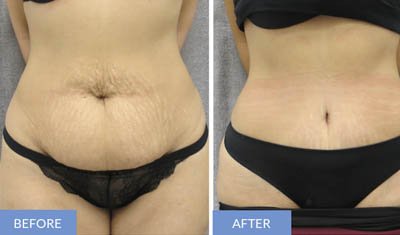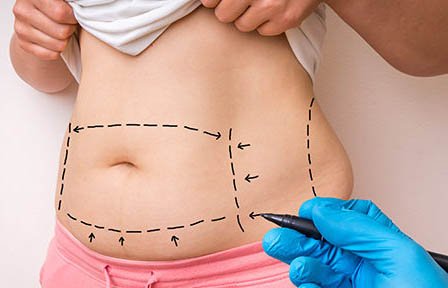Tummy Tuck (Abdominoplasty)

The tummy tuck or abdominoplasty is indicated for people with a flabby abdomen, with slight excess skin and abdominal distention or bulging, that despite the exercise or diets can not be corrected.
Normally these circumstances usually occur after pregnancy in women or after significant weight loss after presenting an overweight or obese maintained over time.
How is the tummy tuck operation?
It is done through an incision in the natural fold of the lower abdomen, above the pubic bone and elongated to the sides as needed influenced by the degree of sagging and excess skin.
From this, the skin and excess fat from the abdominal muscles off and the muscles tighten by sutures if required,then eliminating the excess dermograso suitable for a firm and flat abdomen, relocating the navel into position and suturing the incision without excessive stress on the scar, in order to optimize future development and minimize their visibility.
London Clinical sometimes also associate liposuction of the lateral zonesif there are inadequate abdominal fat deposits, to improve abdominal silhouette and patient satisfaction.
Finally, we put a bandage to minimize the risk of accumulation and improve skin retraction after emptying fat and patient comfort.
What is the procedure?
Depending on the abdomen that want to be treated and the problem you want to correct a type of surgery or another place, with its attendant risks and contraindications, so it is important to make a correct diagnosis.
It is important to see if the region is to operate is above or below the navel and if the problem at hand affects the muscles, skin or if an excess of fat. Generally, the patient will receive general anesthesia or be given an epidural. According to the Spanish Society of Aesthetic Surgery (EU ETS), the duration of the operation is usually between two and five hours, and hospitalization time can be two days.
The procedure, as a rule, leave marks like any other operation. The scar will vary in location or size, the most typical is like a circle around the navel, and another that is located above the pubis and on both sides of the English. Menendez-Graíño argues that, “is the / the patient heals and quality of the scar will depend largely on their scarred trend, ” so the brand remains of the surgery will depend on each patient.
Types of abdominoplasty
According to Menendez-Graíño, the procedures to be made to the person in the abdominal wall, they will be evaluated by a competent professional who will assess the advantages and disadvantages of each procedure. Ente these we find:
- Liposuction: is done when the person only has an excess of fat in the abdomen, but the muscle and skin are fine.
- Miniabdominoplastia without umbilical detachment: if there is a slight excess skin and fat in the lower region of the navel abdominal plastic surgery is performed. In this procedure the navel is not touched.
- Miniabdominoplastia with umbilical detachment: this abdominoplasty is indicated in persons similarly to the previous situation, but a moderate excess skin in the region that lies above the umblical region.
- Abdominoplasty vertical scar: when plenty more skin than in the previous cases, separate the navel of the patient’s skin and then resected and removed again navel. Patients undergoing this operation frequently keep a small vertical scar above the area.
- Abdominoplasty blooming Lys: this variety is practiced only in cases where too much skin left over.
- Classic abdominoplasty or standart: for cases where a lot of skin left over catch the excess of the umbilical region and unite with the pubis and English. The mark resulting from the operation is usually easy to conceal.
- Abdominoplasty with lateral extensions: this intervention serves to correct the excesses on the sides of the abdomen.
- Circumferential abdominoplasty or contornoplastia: indicated in situations where a person loses a lot of weight and has plenty exaggerated skin all regions. In these situations, according to Menendez-Graíño, the scar extends above the buttocks.
- Abdominoplasty or reverse ascending: in these abdominal plastic surgery, excess skin is located in the area above the navel. This joins the breasts to increase their size advantage.

Preparation prior to abdominoplasty
From the AECEP advise people who are going to undergo a tummy tuck to follow the following recommendations :
- Avoid snuff, this may cause problems slowly healing.
- Try to maintain a stable weight six months before the procedure.
- Maintain adequate hydration of the abdominal skin.
- Do not consume drugs or foods (like garlic), which may alter the clotting of blood, at least ten days before.
- Make a check before surgery to rule out hernias or other problems that may cause difficulties in the procedure.
Risks of abdominoplasty
Abdominal plastic surgery, as any operation, has associated risks in general that can be reduced with due care. These are:
- Infection.
- Hematomas.
- abnormal scarring.
- Risks of anesthesia, as a mild mental confusion after waking up or suffer damage to the vocal cords.
Besides these, abdominoplasty has a specific dangers, such as:
- pulmonary complications or abdominal cavity. They are rare.
- Fluid collections.
- Loss of skin that increases the size of scars.
- Navel strange positions.
- Alterations in skin sensitivity.
What kind of anesthesia is used in a tummy tuck?
To perform this procedure usually practice a general anesthesia, prior preoperative study because usually lasts between two and four hours.
The patient is admitted for 1 or 2 days, and was discharged with a bandage which may include drainage until the fourth postoperative day where it is replaced by an elastic band that allows the shower and should be maintained during the first month.
How long is the recovery of abdominoplasty?
Abdominoplasty recovery is somewhat slower than others made in plastic and cosmetic surgery, so you must have help during the first 3-4 days and follow the instructions your surgeon.
It should be performed rest at home during the first week, giving up smoking and taking steps to prevent formation of venous thrombi (although these measures already initiated in the operating room by the medical team).
During the second week after surgery the patient is being incorporated into a normal life sedentary to begin their working lives at two or three weeks after surgery, depending on their work. Not being recommended sports activities during the first postoperative month and abdominal exercises involving up to the third month.

How long are the results?
The change is visible from day one, but will be developed during the first months, so the valuation result from the third month, although we control the patient during the first year for more attention and quality.
The results are permanent, if there are no major changes or new pregnancy weight so we recommend this treatment in patients with stable weight and in women who already do not intend to have more children.
What is the best time for Abdominoplasty?
This procedure can be performed throughout the year, although in summer it is important to avoid sun exposure.Because otherwise it could cause permanent skin pigmentation.
After abdominoplasty
After the passage of the patient under the knife, it can remain in the hospital one to two days to recover. In this period experts will place an abdominal protection, usually a strip.
In addition, the president of the AECEP indicates that in some cases, specialists can tell the patient to take painkillers for pain and discomfort that may have during the first few days after the procedure.
Another advice is to walk hunched over, so you can reduce the stress generated in the scar of the abdomen during the first days after treatment. Although the stitches are removed once a week has passed, experts recommend avoiding sports until the wound heals poorly, about four weeks later.
In addition, it is preferable to avoid fluctuations in the patient ‘s weight, try to maintain a proper habit for skin hydration and perform regular exercise to strengthen the region.
